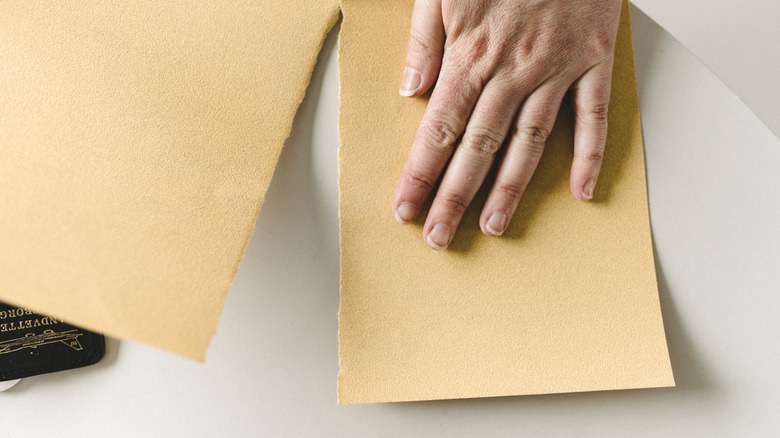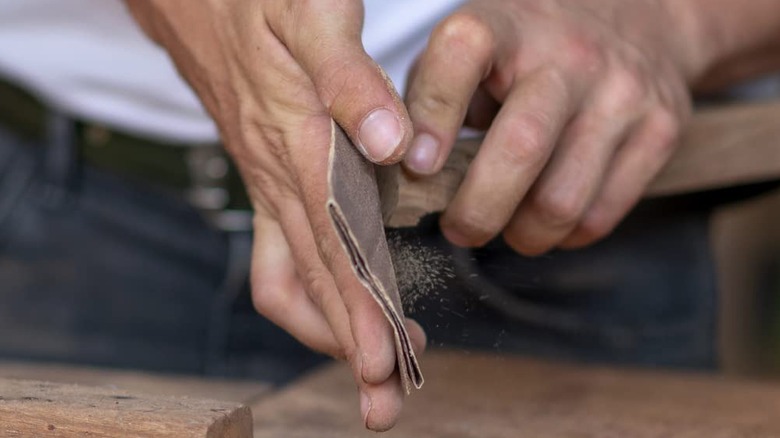Is This DIY For Sanding Difficult Spots Worth It Or A Waste Of Time?
We may receive a commission on purchases made from links.
Do you love finding unique pieces of furniture at thrift stores or even at the end of someone's driveway, just begging to be updated with a good scrub and fresh coat of paint? There are countless upcycling ideas to transform thrifted furniture instead of buying new pieces. As more people embrace refinishing furniture made of solid wood, not a day goes by before someone shares a new hack online that purports to make part of the process much easier. Recently, online furniture flippers have shared a hack to sanding spindles with a piece of duct tape and sandpaper, fashioned into long strips that appear to be perfect for sanding around curves. Finding ourselves a little skeptical of this hack, we decided to ask Bob Beacham, House Digest's expert carpenter and remodeler, for his thoughts.
"I can see that it works, I'm just wondering why you would do it," Beacham said in his exclusive interview with House Digest. "Why not just cut strips of sandpaper? Why add the duct tape?" he wondered. Beacham said that he was so puzzled by the approach he went out to his own shed to figure out why anyone would go to the trouble by checking his own sandpaper. "Then it struck me," he said. "Maybe she buys cheap paper that tears easily. I always buy cloth-backed."
Use cloth-backed sandpaper or make your own sanding files instead
Although you could certainly try this sanding hack by adding strips of duct tape to the backing of a sheet of sandpaper before tearing it into thin strips, according to Bob Beacham, if you need to sand a difficult spot, there are other ways he would do it. "It's good for spindles on chairs, tables, and stairs," he told House Digest during his exclusive interview. "It'll work, no problem, but ... I wouldn't need to add the tape. The sandpaper I use would not tear, break, or split. I'd just cut strips off."
If you're refurbishing your wooden furniture, Beacham recommends making your own small sanding files. "For tricky inside corners ... cut a narrow strip of plywood, cut a 45-degree angle on the end (so effectively you've got a pointer), glue a piece of sandpaper to it, and weigh it down until it sets," he said. The carpentry expert said he takes this approach for small or delicate projects in his own workshop, making a variety of the little file "sticks" to use, both with and without points. Beacham admitted that there are times when you just can't reach a spot with a sanding block or sponge. On those occasions, he said that the strip hack could be acceptable for curved surfaces. But it isn't right for flat objects. For those, he recommended using "a power sander, a sanding block, or wrap the sandpaper around a piece of scrap wood."
Cheap sandpaper wears out more quickly
This hack may be tempting if you're doing woodworking projects for beginners. But Bob Beacham wasn't totally convinced. "Trying to save money on sandpaper can be a false economy," he cautioned during his exclusive interview with House Digest. "It's fine if you're only tackling one project, but cheap sandpaper tends to wear quickly." Beacham also said that even if you can use this hack to sand difficult spots, it's a bad idea to use a low-quality sandpaper on the rest of your project. "When you wrap it around a block, it can crack, and the abrasive coating flakes off," he explained. He strongly recommends investing in rolls of cloth-backed sandpaper, which are lighter, flexible enough to sand tricky areas, and will last longer. "I've never done the math to compare it with the cheap stuff, but I bet it doesn't cost me a lot more," the carpentry expert said, adding that cloth-backed sandpaper is "much nicer to work with."
We decided to do a little digging to see if the type of sandpaper sheets used for this hack are worth it in terms of price. You can get more than twice as much material from Fandeli Multi-Purpose Sanding Paper; it comes with 25 sheets, but only three grit strengths. By the time you add a roll of Original Duck Tape, you'll spend at least $24 on the materials needed to do this sanding hack. Meanwhile, the Emery Cloth Roll comes with two additional grits for $16, but you won't have as much sandpaper for your project. So, whether it's worth it depends on the overall paper quality and quantity of sandpaper you need.


